
The family Scarabaeidae, as currently defined, consists of over 35,000 species of beetles worldwide; they are often called scarabs or scarab beetles. The classification of this family has undergone significant change in recent years. Several subfamilies have been elevated to family rank, and some reduced to lower ranks. The subfamilies listed in this article are in accordance with those in Catalog of Life (2023).
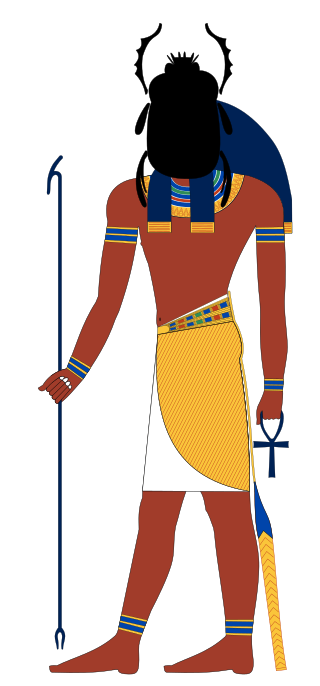
Khepri is a scarab-faced god in ancient Egyptian religion who represents the rising or morning sun. By extension, he can also represent creation and the renewal of life.

Kleptoparasitism is a form of feeding in which one animal deliberately takes food from another. The strategy is evolutionarily stable when stealing is less costly than direct feeding, such as when food is scarce or when victims are abundant. Many kleptoparasites are arthropods, especially bees and wasps, but including some true flies, dung beetles, bugs, and spiders. Cuckoo bees are specialized kleptoparasites which lay their eggs either on the pollen masses made by other bees, or on the insect hosts of parasitoid wasps. They are an instance of Emery's rule, which states that insect social parasites tend to be closely related to their hosts. The behavior occurs, too, in vertebrates including birds such as skuas, which persistently chase other seabirds until they disgorge their food, and carnivorous mammals such as spotted hyenas and lions. Other species opportunistically indulge in kleptoparasitism.

Dung beetles are beetles that feed on feces. Some species of dung beetles can bury dung 250 times their own mass in one night.

The scarab beetle subfamily Scarabaeinae consists of species collectively called true dung beetles. Most of the beetles of this subfamily feed exclusively on dung. However, some may feed on decomposing matter including carrion, decaying fruits and fungi. Dung beetles can be placed into three structural guilds based on their method of dung processing namely rollers (telecoprids), dwellers (endocoprids) and tunnelers (paracoprids). Dung removal and burial by dung beetles result in ecological benefits such as soil aeration and fertilization; improved nutrient cycling and uptake by plants, increase in Pasture quality, biological control of pest flies and intestinal parasites and secondary seed dispersal. Well-known members include the genera Scarabaeus and Sisyphus, and Phanaeus vindex.

Cracker butterflies are a Neotropical group of medium-sized brush-footed butterfly species of the genus Hamadryas. They acquired their common name due to the unusual way that males produce a "cracking" sound as part of their territorial displays. The most comprehensive work about their ecology and behavior is that of Julian Monge Najera et al. (1998). The genus was erected by Jacob Hübner in 1806.

Scarabaeus sacer, common name sacred scarab, is the type species of the genus Scarabaeus and the family Scarabaeidae. This dung beetle is native of southern Europe, northern Africa and western Asia, and it was venerated in ancient Egypt.

Sisyphus is a genus of dung beetles comprising more than 90 species. Adults are characterised by their long hind legs.
Cephalodesmius is a genus of Scarabaeidae or scarab beetles.

Epirinus is a genus of dung beetles in the tribe Deltochilini of the scarab family. It comprises 29 species from southern Africa; a few species are widespread in the region, but most have limited ranges. Length ranges from 3.0 mm to 13.5 mm.
The Australian Dung Beetle Project (1965–1985), conceived and led by Dr George Bornemissza of the Commonwealth Scientific and Industrial Research Organisation (CSIRO), was an international scientific research and biological control project with the primary goal to control the polluting effects of cattle dung.

Heliocopris is a genus of Scarabaeidae or scarab beetles in the superfamily Scarabaeoidea. Forty-seven of the fifty-two known species are found in Africa, but a few are found in southern and southeast Asia.
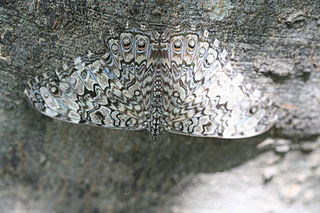
Hamadryas februa, the graycracker, is a species of cracker butterfly in the family Nymphalidae. It is found from Argentina north through tropical America to Mexico. Rare strays can be found up to the lower Rio Grande Valley in southern Texas. The habitat consists of subtropical forests, forest edges and cultivated areas with trees.
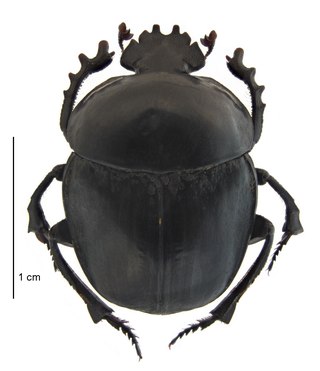
Sceliages, Westwood,, is a sub-genus of the Scarabaeus dung beetles, and are obligate predators of spirostreptid, spirobolid and julid millipedes, having renounced the coprophagy for which they were named. The genus is near-endemic to Southern Africa, Sceliages augias exceptionally ranging as far north as the Democratic Republic of Congo.

Phanaeus, the rainbow scarabs, is a genus of true dung beetles in the family Scarabaeidae, ranging from the United States to northern Argentina, with the highest species richness in Mexico. Depending on species, they can inhabit a wide range of habitats, from tropical to temperate climates and deserts to rainforests. In those living in relatively arid places adults are primarily active during the wet season and those living in relatively cold places are primarily active during the summer. They are excellent diggers and good fliers.

Coprini is a tribe of scarab beetles, in the dung beetle subfamily (Scarabaeinae). Scholtz et al. describe them as tunnellers that are shiny black, of moderate to large size and with a strongly convex shape. They also, however state that the grouping based on these characteristics has little phylogenetic validity, and the placement of several genera in this and related tribes is likely to change.
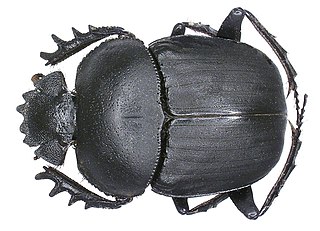
Scarabaeus ambiguus is a species of Old World dung beetles. This beetle rolls up a ball of dung before laying eggs on it and burying it.

Heliocopris bucephalus, commonly known as Elephant dung beetle, is a species of dung beetle found in India, Sri Lanka, Bangladesh, Myanmar, Malay Peninsula, Java, Vietnam, Laos, and Cambodia.

Ceratocaryum argenteum, commonly known as silver arrowreed, is a species of plant in the Restionaceae family and is native to the Cape Provinces of South Africa.
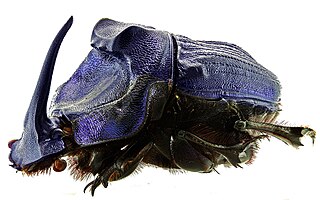
Coprophanaeus lancifer is a large species of beetle belonging to the family Scarabaeidae. It is found widely in the Amazon rainforest in South America and it is often common.


















